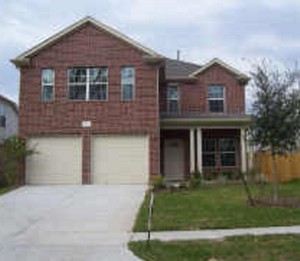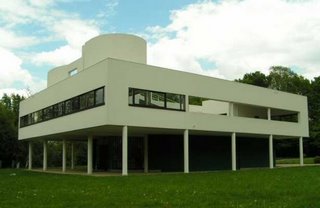Dwelling on a dwelling
 Typical suburban home (right)
Typical suburban home (right)
Le Corbusier's Villa Savoye (left)
Ares: “We need a house.”
Me: “I don’t want a house.”
Ares: “Why?”
Me: “Looking for a house is depressing. I refuse to spend my time sifting through the meaningless piles of drywall, stucco, and shingles bonded together thoughtlessly, to try to find the one dwelling that successfully marries practicality with aesthetics. I refuse to admit ownership of something I don't like”
Ares: (Confused) “What?!”
Me: “There’s just nothing out there that I like.”
Ares: “Want to look at new construction? We can always build one.”
Me: “No… unless you’re growing money in the patio.”
That conversation lead me to this argument: is good design reserved only for an elite group with keen eyes and deep pockets? You know the type, the ones whose black Barcelona chairs and Corbusier table welcome you to their Rietveld-inspired home. A Tolomeo lamp hovering over a Noguchi, a Pollock hanging alongside a Kandinsky, while a Neo-classical composer takes a stab at Mozart on the Bang & Olufsen. There’s meaning in every piece, a thought process that solidified from abstract to reality. No need for ornamentation, just the obvious representation of an idea; a less is more kind of approach.
The notion that those with buying power can achieve more with their currency is not new. For years, those of us who lack such financial muscle have been subjected to the grotesque monsters concocted by the minds of developers and builders who have their own economic hunger to feed. Remember Levittown? If you’re not convinced, then please take a drive to suburban Houston –or really, anywhere else in suburban America- and see what $200k buys you: a box, piled among a sea of other colossal boxes, in neighborhoods ruled by dictatorships under the aliases of ‘Homeowners Association’. The formula is always the same: a two-car garage right smack in front of the house, a dead tree planted right in the middle of the front lawn, a concrete path leading to the leaded-glass front door, manicured patches of grass and soil bearing the sign ‘Lawn-of-the-month’. You’ll get walls covered in flowers, floors that look like wood and feel like plastic, plantation shutters that don’t shut, arches, cubby-holes and other left-over spaces labeled ‘computer desk area’, beige carpet, molding, chair rails, and brass lighting fixtures -right out of a Home Depot catalog- burning 15 bulbs at a time. It’s a scene that will repeat itself just 50 feet down the road: brick, mortar and siding clumped carelessly, implanted on patches of land, hundreds to an acre.
What won’t your well-earned money get you? Forethought, quality, individuality…a unique world that enhances your everyday living experience. Nowhere has the time been taken to create a dialogue between site and building, to eliminate clutter, to bring forth that which enriches our living experience, not just ornament it. Why? Because time is money for those who exercise the right to decide the direction in which our built environment will derail. Whatever happened to Le Corbusier’s discourses on the house as a machine for living? What about Phillip Johnson and his minimalist and functional Glass House? Where is Frank Ghery and his theories on the use of ordinary (read: inexpensive) materials to create beautiful (read: comfortable) spaces for living? Where in suburban America? Nowhere! It’s cookie-cutter at its best. Hence the thought persists, is the question here really about money, or are we just plain lazy? Who then, will prevent new neighborhoods from becoming virtual Candy Lands?
Definitely not these people!


5 Comments:
The problem lies deep withing our individual selves and society. In a place so dark people seldom admit it. It's called interest. And you could get involved reading a hundred books from recognized authors on sociology, psycology, economics, and other social ciences, but none of those recongnized authors will change the truth. The individual egoism still exist. Doesn't matter how it develops, what matters right now it's that it's there. It's been there always, and for now it looks like it will stay within society and ourselves until the end of humanity.
What is the result of individual and colective self-interest?
Things like the one you and millions of other americans are living in. These proyects are product of sucessful 'business-minded', 'practical', american entrepeneurs whose single objective is to produce as much income as possible with as little loss as possible.
That mentality is impregnated in every current business and market that you can think of. Nobody wants to do more for less...
Whatever...
Not all the suburbs are cookie-cutters. Take a look at the older neighborhoods that were built in the mid-70's. I am not saying you will find a masterpiece out there, but you sure as hell won't find two matching floor plans or forget which house is yours. The neighborhoods we have been looking in have actual real trees (anywhere from 8-20 full grown mature trees on each lot) and unique creole, victorian, ranch, and traditional style homes. No matching brick throughout the entire neighborhood. All the houses are not at the exact same distance from the street. All the houses are unique - some even have hidden surprises inside such as amazing atriums or greek style bathrooms.
WOW sounds like when I was living back in Vegas where all corners look the same (Smith's, Walgreens or a CVS, some Chineese food place, etc, etc) and all for the price of $250,000 and up. No way to tel one corner from the next...feeling like a Stepford wife or living within The Sims game. Lack of individulaity and a feeling I was getting ripped of by people who construct walls that you can literraly punch a hole through with the strength of a 2 yr old. Real pity how it has come down to selling a commodity with the feel of sameness... shame shame!!
"...is good design reserved only for an elite group with keen eyes and deep pockets?"
In a word? Yes. You get what you pay for. There are some older homes with good designs in the same price ranges as the suburban horrors, but you have to update them.
What about Sugarwood or Sugar Creek?
Post a Comment
<< Home